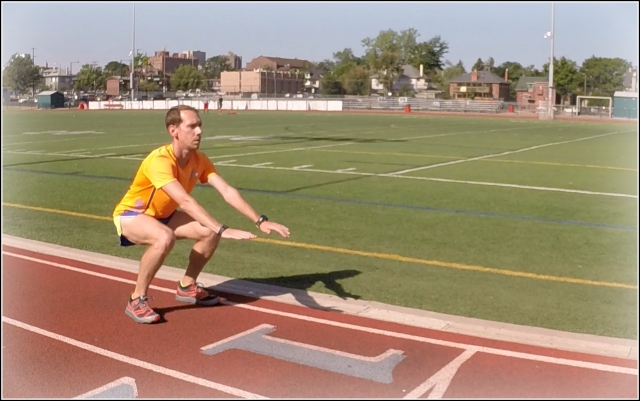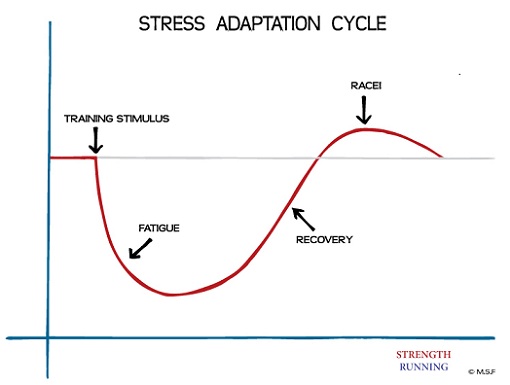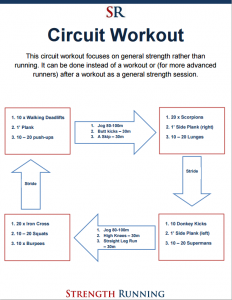Can you gain endurance AND strength – with just one workout? Yes, you can accomplish both goals with a circuit workout!

Circuits usually make people think of CrossFit WOD’s and AMRAP sessions – but they’re for runners, too.
When runners implement circuits into their training, they typically alternate between running and strength exercises. It can be a higher intensity workout while providing significant gains in endurance and strength.
I personally love circuit workouts because of their variability and flexiblity – you can create almost any type of circuit workout for any type of runner:
- beginners
- older athletes
- young runners
- those prone to injury
- even elite runners (watch Shalane Flanagan’s circuit workout)!
And over the last few months, I’ve been incorporating more circuits into my own training. Since my ultra DNF, I’ve been running fast without any injuries, partly because of these types of workouts.
Now I want to explain them in more depth, including who should run them, why you should consider them, and different types of circuit training for runners.
The Benefits of Circuit Workouts for Runners
The beauty of circuits is that they combine faster repetitions with strength exercises – so you can get the benefits of both.
More speed and strength… with less injuries?
Yes! It’s an efficient way to get many benefits, especially if you’re strapped for time.
Most circuit workouts have less total running than “normal” workouts, so they’re low-volume. And when low-volume workouts are combined with strength exercises, they’re a great type of workout for new runners or those who struggle with running injuries.
But the session is still incredibly effective because your heart rate stays high during the strength portion of the workout.
So you’re exercising for a longer period of time with less running. You’re getting the aerobic stimulus of a longer run, without all the pounding.
Plus, circuit workouts improve your overall athleticism – and better athletes make better runners. You’ll enjoy:
- Improved balance
- Increased strength
- More flexibility
By incorporating strength exercises that force you to move in multiple planes of motion (instead of just straight ahead like running), you’ll reduce your injury risk by improving your ability to move more efficiently.
Even if the running portion of the circuit is done at an easy pace, your heart rate stays elevated for a longer period of time, improving the endurance benefits of the run.
This option – keeping all of the running segments easy – is best for new runners who haven’t yet done any faster running.
Introducing: The Sickle Circuit Workout
Recently I was asked by Buzzfeed to design a workout that builds strength and endurance. I created a circuit workout – one that alternates strength exercises with running.
You can see the circuit workout here, as well as many other cardiovascular-oriented types of workouts.
I love this specific circuit because it’s incredibly simple and you can perform it with no equipment. You don’t need to be on a track like I am in the video demonstration below; a marked path or GPS estimate is fine, too.
Let’s take a look at a video demonstratioin of the Sickle Circuit Workout so you can see how it’s executed in more detail.
A few notes about how to run circuits:
- You don’t have to run the repetitions at a fast pace – you can also do them at an easy pace if you’re recovering from an injury or a beginner runner
- There’s no need to rush the recovery portion of the workout (notice how I stand for a few seconds before starting the next rep)
- The video above isn’t in real time! I clipped out the boring parts 🙂
- More advanced runners can do a short circuit after a faster workout
- You can download a more advanced circuit workout here.
While doing circuits, remember that you’ll feel more tired during the strength exercises than if you were fully rested. That means it’s even more important to focus on form and proper execution of each exercise.
For more workouts, check out the 52 Workouts, 52 Weeks, One Faster Runner book.
Who should run circuit workouts?
Circuit workouts are great additions to a training program for a variety of people and situations.
If you’re coming back from an injury, you have to train at a lower volume (less mileage) after an injury, so this helps you still get in a hard workout with much less risk of reinjury.
There’s also a strong emphasis on building strength which will help you prevent injuries in the future.
If you’re training for an obstacle race (like Tough Mudder, Warrior Dash, or Spartan Race) there’s a bigger focus on strength during the event itself.
Circuit workouts mimic the demands of the race, making them a race-specific session that can be utilized during the base phase and competition phase of training.
Obstacle racers should also incorporate more difficult exercises to prepare for the race, like those that use a medicine ball.
For more obstacle racing advice, get the free OCR report here.
You’re new to running. New runners face a unique challenge: they can often run farther than their body can actually handle.
This is an example of their “engine” (aerobic fitness) being stronger than their “chassis” (structural fitness – bones, tendons, muscles, and ligaments).
A 6-mile run might be entirely possible after a few weeks, but the strength of their muscles and connectives tissues haven’t “caught up” with their endurance yet.
You can see this principle in action in the Stress-Adaptation graph below. The adaptation for “structural fitness” simply takes longer than endurance adaptations:

The compromise is to run a circuit workout. Beginner runners can increase their strength while running a hard workout that’s not too long.
Are there other types of circuit workouts?
Circuit workouts are incredibly versatile. You can literally create an unlimited number of circuit workouts – the only limit is your imagination.
Play with a few variables to fit your goals:
- The number of strength exercises – and the number of repetitons of each
- The difficulty of strength work
- The pace of the running repetitions
- The amount of recovery between each repetition
- The distance of each repetition
- Incorporating drills or plyometric exercises instead of strength exercises
As you can see, there’s so many options!
There’s also a more comprehensive, advanced circuit workout available to Strength Running subscribers (in addition to other workouts, running lessons, and downloads).
Download the advanced circuit workout here – it’s free.
This circuit focuses more on speed with strides, form drills, easy running, and bodyweight strength exercises.
It’s best to start with a simpler, easier circuit like the Sickle Workout.
Once you’re comfortable combining running with strength exercises, you can progress to a more challenging routine like the free download above.